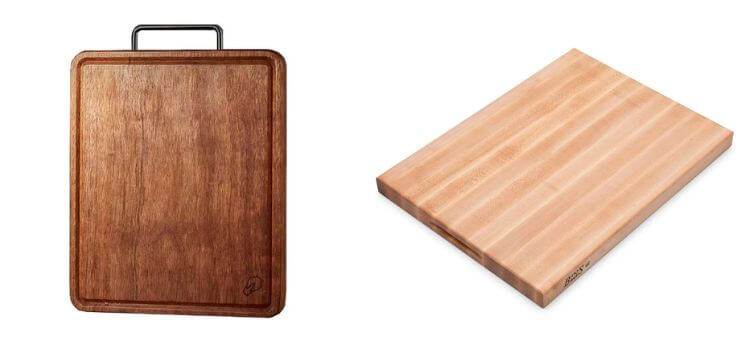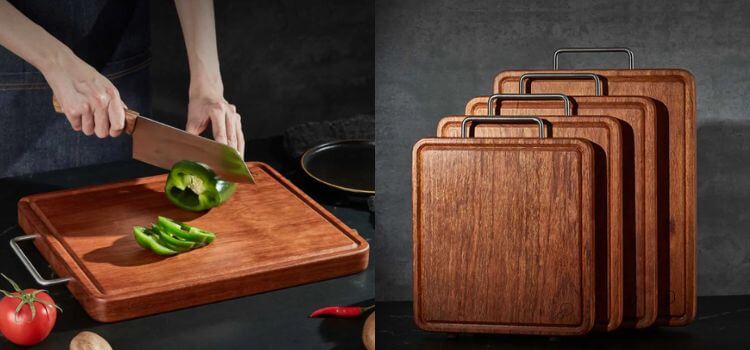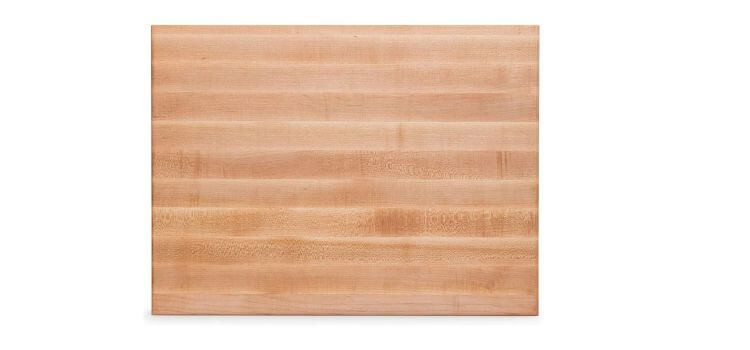As an Amazon Associate, I earn from qualifying purchases

In the world of culinary arts, the choice of cutting board can make a significant difference in functionality and aesthetics. Two popular options often vie for the top spot are cherry and maple, which are cutting boards. Each wood type brings unique qualities to the kitchen table, from durability to grain patterns.
Embark on a journey with us as we explore the unique qualities of cherry and maple cutting boards. We will dissect their advantages and limitations, guiding you towards making a well-informed choice for your culinary endeavors.
Characteristics of Cherry Cutting Boards

Cherry is a hardwood known for its strength and durability, making it an excellent choice for cutting boards that can withstand heavy use. The wood has a fine to medium-grain pattern, with occasional pin knots characterizing it. Cherry also boasts a beautiful reddish-brown color that adds warmth and charm to any kitchen setting.
Benefits and Drawbacks
One of the main benefits of using a cherry cutting board is its natural resistance to bacteria and mould. This renders it a secure choice for preparing food, as long as proper cleaning and maintenance are practiced.
However, cherry wood can be more susceptible to scratches and knife marks than harder woods like maple.
Characteristics of Maple Cutting Boards

Maple is a dense and hard wood popular in the kitchen for its durability. It has a fine, uniform grain pattern with minimal knots, making it look sleek and even. Maple also has a light color ranging from creamy white to pale yellow, making it an attractive addition to any kitchen.
Benefits or Drawbacks
One of the main advantages of using a maple cutting board is its hardness, making it less prone to scratches and knife marks. This also means it will last longer and require less frequent replacement than softer woods like cherry.
However, maple can be more challenging to maintain due to its propensity to absorb moisture, If not adequately maintained, this can result in warping or cracking.
Aesthetics and Design: Cherry vs Maple Cutting Board
Both cherry and maple cutting boards have their own unique aesthetic appeal, making them popular choices for kitchen decor. Cherry’s warm reddish-brown color adds a touch of elegance and sophistication to any countertop. At the same time, maple’s light and neutral tones can complement a modern or minimalist kitchen design.
How to choose based on kitchen style
Consider your kitchen’s overall style and design when choosing between cherry and maple cutting boards. If you have a traditional or rustic kitchen, cherry may be the better option to complement the warm and cozy feel. Maple may be a better fit for a more contemporary or sleek kitchen with its light and clean appearance.
Aside from color, the grain pattern of each wood can also play a role in how it complements different kitchen styles. The occasional knots and swirls in cherry create a more natural and rustic look, while the uniform grain of maple adds to its clean and modern appeal. Ultimately, choosing between cherry and maple cutting boards can also be a personal preference.
Performance and Durability: Cherry vs Maple Cutting Board

In terms of performance and durability, both cherry and maple cutting boards have their strengths. Cherry’s natural resistance to bacteria makes it a safe option for food preparation.
However, its softer nature can make it more susceptible to knife marks and scratches, requiring regular sanding or oiling to maintain its smooth surface.
On the other hand, maple’s hardness makes it less prone to knife marks, However, maintaining it can be more difficult because of its propensity to absorb moisture. Maple cutting boards should not be left in water or exposed to extreme heat to prevent warping or cracking. They also require regular oiling to keep the wood hydrated and prevent drying out.
Both cherry and maple cutting boards can withstand regular kitchen use with proper maintenance. However, maple may have the upper hand in terms of longevity due to its hardness and resistance to knife marks.
With regular oiling and avoiding prolonged exposure to heat or moisture, a maple cutting board can last many years without needing replacement. Cherry cutting boards require more frequent sanding or oiling to maintain their surface, but they can also last for a considerable amount of time with proper care.
Ultimately, the durability of each wood type depends on how well it is maintained and cared for in the kitchen.
Maintenance and Care Tips
Both cherry and maple cutting boards necessitate consistent upkeep to extend their durability and maintain their prime condition. Here are some practical tips for caring for each type of wood:
- Cherry Cutting Boards: Due to their natural resistance to bacteria, they only need simple cleaning with hot water and mild soap after use. Avoid prolonged exposure to heat or soaking in water, this can lead to warping or cracking. Regularly sand the board with fine-grit sandpaper and apply food-safe mineral oil to prevent scratches and maintain its smooth surface.
- Maple Cutting Boards: After each use, maple cutting boards should be thoroughly cleaned using hot water and a gentle soap. Avoid harsh detergents or abrasive cleaning tools, as they damage the wood. Regularly oil the board with food-safe mineral oil to prevent drying out and cracking. If the board becomes warped, place it in a warm oven (around 175-200 degrees Fahrenheit) for a short time to dry it out and then re-oil to restore its shape.
Conclusion
In conclusion, cherry and maple cutting boards have unique characteristics and benefits. Cherry is known for its natural resistance to bacteria and warm aesthetic appeal, while maple boasts its hardness and modern design.
When choosing between the two wood types, consider your kitchen style, maintenance preferences, and how each wood’s performance and durability align with your needs. With proper care, either cherry or maple cutting boards can be a valuable and long-lasting addition to your kitchen.
By following these tips and selecting the right wood based on your preferences, you can enjoy the benefits of a high-quality cutting board for years!
As an Amazon Associate, I earn from qualifying purchases
Pingback: How To Fix Warped Cutting Board